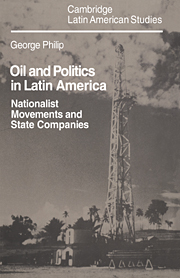Book contents
- Frontmatter
- Contents
- List of tables
- Preface
- Glossary
- Abbreviations
- Note on currencies and other units of measurement
- Maps: Latin America in 1920, 1940, 1960 and 1981; showing importing countries, exporting countries and countries self-sufficient in oil
- Introduction: The politics of oil in twentieth-century Latin America
- Part I The world oil environment
- Part II The major expropriations
- 7 Politics and the concession contract
- 8 Argentina: YPF, Yrigoyen and the 1935 oil law
- 9 Some nationalisations of the 1930s: Chile, Uruguay, Bolivia
- 10 Cárdenas and the Mexican oil nationalisation
- 11 The formation of Petrobrás
- 12 The nationalisation of the ipc in Peru
- 13 The nationalisation of Gulf Oil in Bolivia 1969
- 14 Oil politics in Ecuador 1972–6
- 15 The nationalisation of oil in Venezuela
- 16 Oil companies and governments in twentieth-century Latin America
- Part III The state oil companies
- Notes and bibliography
- Index
- CAMBRIDGE LATIN AMERICAN STUDIES
15 - The nationalisation of oil in Venezuela
Published online by Cambridge University Press: 23 December 2009
- Frontmatter
- Contents
- List of tables
- Preface
- Glossary
- Abbreviations
- Note on currencies and other units of measurement
- Maps: Latin America in 1920, 1940, 1960 and 1981; showing importing countries, exporting countries and countries self-sufficient in oil
- Introduction: The politics of oil in twentieth-century Latin America
- Part I The world oil environment
- Part II The major expropriations
- 7 Politics and the concession contract
- 8 Argentina: YPF, Yrigoyen and the 1935 oil law
- 9 Some nationalisations of the 1930s: Chile, Uruguay, Bolivia
- 10 Cárdenas and the Mexican oil nationalisation
- 11 The formation of Petrobrás
- 12 The nationalisation of the ipc in Peru
- 13 The nationalisation of Gulf Oil in Bolivia 1969
- 14 Oil politics in Ecuador 1972–6
- 15 The nationalisation of oil in Venezuela
- 16 Oil companies and governments in twentieth-century Latin America
- Part III The state oil companies
- Notes and bibliography
- Index
- CAMBRIDGE LATIN AMERICAN STUDIES
Summary
The Venezuelan nationalisation took place 53 years after oil production first began. Although the roots of the nationalisation in some ways go back as far as the companies themselves, the takeover followed many years of relative tranquillity. Moreover, the nationalisation was (as far as any step of this magnitude can be) a quiet, consensual affair which showed, as clearly as anything could, the lack of serious political conflict within the country. Nevertheless, despite the lack of acrimony or drama at the time of the final takeover, the nationalisation was the logical, perhaps the only, response to a gradually woven web of political and economic constraints which fit into place during the 53 years of oil production.
During this time, massive income had found its way to the Venezuelan Treasury and Venezuelan society. The high profits which the companies earned for many years, the massive corruption of certain of Venezuela's rulers and even the relative weakening of the country's market position after about 1957 were not sufficient to check the impact of oil wealth. With its oil income, the country's political order had been consolidated by successive Venezuelan presidents. Gómez had contented himself with buying the allegiance of Venezuela's military and political elite; López Contreras and Medina Angarita expanded the public service to provide employment for the growing Caracas middle class and the civil service grew in size from 7,000 in 1935 to 47,000 in 1941 and 95,535 in 1954 (by which time it had reached 10% of the non-agricultural labour force).
- Type
- Chapter
- Information
- Oil and Politics in Latin AmericaNationalist Movements and State Companies, pp. 293 - 311Publisher: Cambridge University PressPrint publication year: 1982



